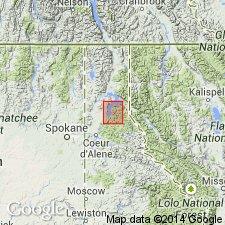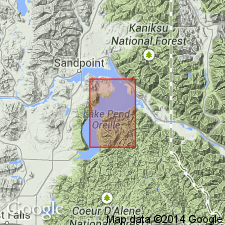
- Usage in publication:
-
- Gold Creek quartzite*
- Modifications:
-
- Named
- Dominant lithology:
-
- Quartzite
- AAPG geologic province:
-
- Idaho Mountains province
Summary:
Named for exposures on North and South Gold Creek near Lakeview, Bonner Co, ID in the Idaho Mountains province. Overlies the Algonkian-aged Striped Peak formation of the Belt series. Underlies the newly named Rennie shale of Middle Cambrian age. Mapped (geologic map) with other Cambrian formations. Designation of a type locality not given. Consists of resistant, coarse-grained, cross-bedded quartzite. Ranges from 200 to 600 ft thick. Forms ridges and cliffs. Is very resistant to weathering.
Source: GNU records (USGS DDS-6; Denver GNULEX).

- Usage in publication:
-
- Gold Creek Quartzite*
- Modifications:
-
- Overview
- AAPG geologic province:
-
- Idaho Mountains province
Summary:
Mapped on west side of Packsaddle Mountain, just south of Pend Oreille Lake, Bonner Co, ID, Idaho Mountains province, where it underlies Rennie Shale locally. Lower contact of Gold Creek is with unit 3, the argillite, siltite, and limestone member of the Wallace Formation of the Belt Supergroup, an unconformable contact. Gold Creek is about 400 ft thick. It has a basal conglomerate and an overlying thin-bedded to thinly cross-bedded, blocky to massive, slightly feldspathic pink to buff or white, fine- to coarse-grained quartzite containing scattered pebbles and beds of pebbles. Some Belt rocks in the conglomerate. Matrix of conglomerate is a poorly sorted sand. Assigned a Middle? Cambrian age. [No evidence for age assignment included. Authors give a more complete lithologic description than Sampson did.]
Source: GNU records (USGS DDS-6; Denver GNULEX).
For more information, please contact Nancy Stamm, Geologic Names Committee Secretary.
Asterisk (*) indicates published by U.S. Geological Survey authors.
"No current usage" (†) implies that a name has been abandoned or has fallen into disuse. Former usage and, if known, replacement name given in parentheses ( ).
Slash (/) indicates name conflicts with nomenclatural guidelines (CSN, 1933; ACSN, 1961, 1970; NACSN, 1983, 2005, 2021). May be explained within brackets ([ ]).

